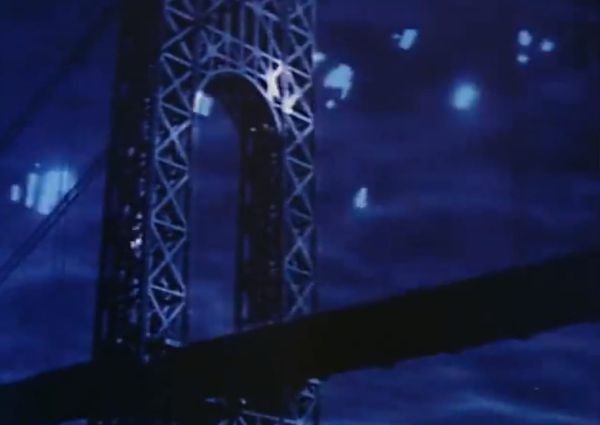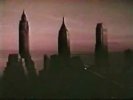Eye For Film >> Movies >> Bridges-Go-Round (1958) Film Review
Bridges-Go-Round
Reviewed by: Chris

Shirley Clarke's Bridges-Go-Round is a short film played twice. Once with a sweeping jazz score and once with electronic music. There is no narrative, just sweeping images of the bridges of New York City. She records these structures driving across them and then superimposes images of the structural steel across the sky. Panning shots in opposite directions are superimposed. It could be argued that the multiple shots seem to have no agenda other than artistic experimentation. A kaleidoscope of bridges with added coloured tints.
But the two ‘versions’ produce different reactions. The lifting jazz score emphasises the curves sweeping towards the sky, the pacing and editing, and the camera movements. The electronic score (by Bebe and Louis Barron, the same composers who scored the 'tonalities' for Forbidden Planet) directs our attention more to the abstract patterns produced as we observe the open steel structures outlined against the sky and against other images of the same bridge.

Many of Clarke's favourite techniques seem to hearken back to those used by the 'city symphony' genre of filmmakers. In a 1928 film by Joris Ivens, The Bridge, we see different viewpoints of a massive iron bridge in Rotterdam. In Bridges-Go-Round, Ivens’ patterns of massive girders are apparent, but Clarke has added lyrical camera panning and superimposition to create a non-linear sense of movement. Many of Clarke’s bridges travel ‘into each other’, creating a ‘symphony’ of geometrical shapes.
Other city symphony methods can be discerned in Clarke’s work.
Chronologically –
1954 In Paris Parks – in spite of its name, this early work focuses on people rather than the city, but still uses the collage structure common to city symphony filmmakers.
1957 The composite shots of Brusssels Loops are perhaps most easily identifiable as a city symphony.
1958 Bridges-Go-Round suggests a direct continuation of city symphony descriptions of a specific structure.
1959 The award-winning Skyscraper adds a coherent diegesis to the visual imagery, painting both a visual picture of a building and a ‘story’ of its construction.
1964 The acclaimed feature length film, The Cool World, uses contrasts of wet and dry streets, a common device employed by city symphony filmmakers to construct a multi-viewpoint ‘feel’ of a city. (The Cool World was extensively praised for its realistic depiction of Harlem.) The use of wet streets to create realistic atmosphere could perhaps be traced to another of Ivens' city symphony films, Rain (1929) which explored the changing look of Amsterdam before and after a shower.
The draw of 'a cinema of the city' is endless. We live in a world where cities are integral to our lives yet our romantic notions of them are played mostly within our own minds, where associations can be montaged or superimposed. The technology of cinema allows the way we dream to be expressed in front of our eyes. A bridge may be wonderful in itself, but a simple photograph cannot articulate the myriad feelings that a favourite structure conjures up. From our memories, we add our favourite associations, incidents, even the songs that were playing. All these things make a structure of steel girders more than simple engineering. They affect the way we think about it. Bridges are a favourite symbol of poets and writers. They feature in mainstream cinema (One only has to think of The Bridges Of Madison County.) Bringing this to conscious awareness is another development and achievement in Bridges-Go-Round. We are forced to acknowledge that different music affects the way we see things. The simplicity of Clarke's object-lesson film demonstrates psychological re-framing in a basic, almost mathematical way.
Reviewed on: 06 Jul 2008














